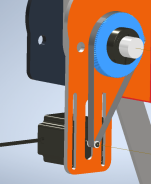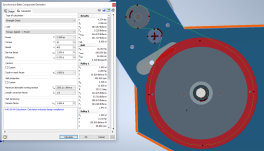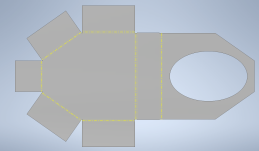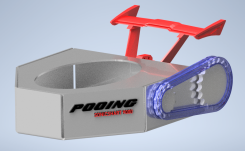Alright, so some background.
1. I like to make accurate miter cuts, often.
3. I have a lot of free time.
4. I'm not an engineer, I just played with legos a lot. Don't trust anything I say.
5. If this seems incomplete, it's because it is! This is a work in progress and will change often.
I decided to undertake the challenge of designing a horizontal dual mitering bandsaw that can be built from a single sheet of 1/4" plate, IKEA style. Doable? Ehh. Fun to try? Ehhhhh.
Firstly I needed to establish the constraints of the project.
1. Should be predominantly laser/waterjet cut plate components. Minimal manual fabrication, just MIG welding/assembly.
2. Should use no specialty components. Only readily attainable Ebay, McMaster, whatever. No castings. No machined parts(yes I realize the irony).
3. Adaptable to a variety of different parts. Motors, bearings,etc. Will be relying heavily on SLOTS and PILLOW BLOCKS. No press-fits here.
4. Be relatively easy to assemble for a novice fabricator. Be adjustable to account for tolerance errors.
5. Have a cut capacity of +/-60 degrees or better.
I started with research and studying existing designs. Dry vs wet. Crowned vs flat pulleys. Desired feature sets. I settle on some constraints and get to work.
I start with a basic sketch and establish some base parameters. I intially started with larger wheels, but decided against it. The larger the wheel, the more material and gear reduction is needed.
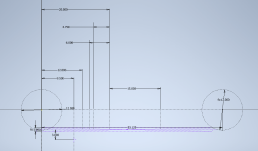

I model some stuff and do some (probably ill-advised)Salvador Dali stress simulations.


I widdle away at material and continue to run stress analyses. Eventually I scrap the whole thing and begin anew because I have some qualms about how it's progessing. I size the 14 inch pulleys down to 12 inch to save on material and gear reduction needs. The cut envelope is still insane.
I'm optimizing for material usage here, so it's rather important to save material and make nest-able geometry.

To make the design more nestable on sheet, I break the pulley down into smaller chunks. They consist of a central wheel with two layers of um..pentadrants? Holes added for clecos/bolts/etc. They are meant to go together as weldments, so the holes are more for temporary indexing than fastening.

I drop the cut files into the nesting program just to see. It makes a remarkable difference.
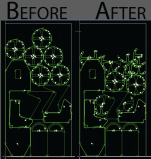
I ponder the gear system a bit. Gearboxes are really expensive. I play around with the Inventor Synchronous Gear Transmission tool. I mess with some different belts and pulley configurations until I settle on a 4.5:1 pulley system with an idler for tensioning. Since I'll be using a VFD to achieve the final RPM I'm only trying to get in the ballpark with my gear reduction.
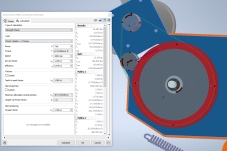
Now I know what you're thinking. That drive pulley is going to cost like $8000 to manufacture. But using similar principals as the blade wheels, I chunk it down into bite-size bits. I add circular cutouts to the driven pulley, and that readily makes a nice little home for the drive pulleys to nest.

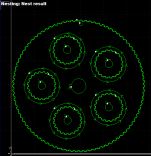
to be continued
1. I like to make accurate miter cuts, often.
3. I have a lot of free time.
4. I'm not an engineer, I just played with legos a lot. Don't trust anything I say.
5. If this seems incomplete, it's because it is! This is a work in progress and will change often.
I decided to undertake the challenge of designing a horizontal dual mitering bandsaw that can be built from a single sheet of 1/4" plate, IKEA style. Doable? Ehh. Fun to try? Ehhhhh.
Firstly I needed to establish the constraints of the project.
1. Should be predominantly laser/waterjet cut plate components. Minimal manual fabrication, just MIG welding/assembly.
2. Should use no specialty components. Only readily attainable Ebay, McMaster, whatever. No castings. No machined parts(yes I realize the irony).
3. Adaptable to a variety of different parts. Motors, bearings,etc. Will be relying heavily on SLOTS and PILLOW BLOCKS. No press-fits here.
4. Be relatively easy to assemble for a novice fabricator. Be adjustable to account for tolerance errors.
5. Have a cut capacity of +/-60 degrees or better.
I started with research and studying existing designs. Dry vs wet. Crowned vs flat pulleys. Desired feature sets. I settle on some constraints and get to work.
I start with a basic sketch and establish some base parameters. I intially started with larger wheels, but decided against it. The larger the wheel, the more material and gear reduction is needed.


I model some stuff and do some (probably ill-advised)


I widdle away at material and continue to run stress analyses. Eventually I scrap the whole thing and begin anew because I have some qualms about how it's progessing. I size the 14 inch pulleys down to 12 inch to save on material and gear reduction needs. The cut envelope is still insane.
I'm optimizing for material usage here, so it's rather important to save material and make nest-able geometry.

To make the design more nestable on sheet, I break the pulley down into smaller chunks. They consist of a central wheel with two layers of um..pentadrants? Holes added for clecos/bolts/etc. They are meant to go together as weldments, so the holes are more for temporary indexing than fastening.

I drop the cut files into the nesting program just to see. It makes a remarkable difference.

I ponder the gear system a bit. Gearboxes are really expensive. I play around with the Inventor Synchronous Gear Transmission tool. I mess with some different belts and pulley configurations until I settle on a 4.5:1 pulley system with an idler for tensioning. Since I'll be using a VFD to achieve the final RPM I'm only trying to get in the ballpark with my gear reduction.

Now I know what you're thinking. That drive pulley is going to cost like $8000 to manufacture. But using similar principals as the blade wheels, I chunk it down into bite-size bits. I add circular cutouts to the driven pulley, and that readily makes a nice little home for the drive pulleys to nest.


to be continued


